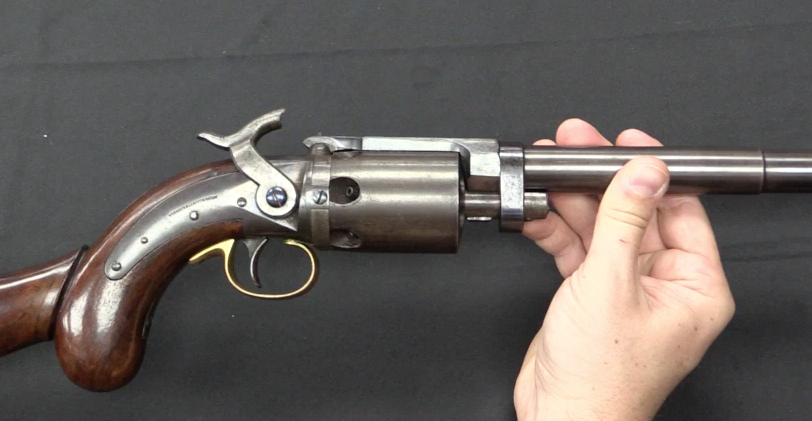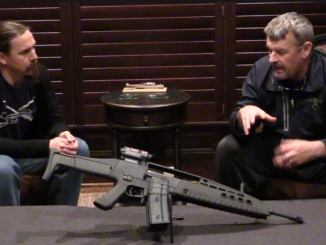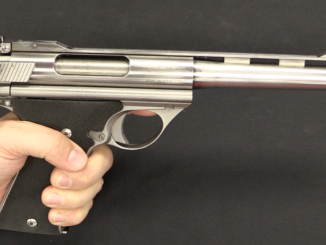The Burnside carbine was originally invented by Ambrose Burnside – the man who would later command the Army of the Potomac and after whom sideburns would be named. Burnside came up with the idea while stationed in Mexico as a young officer, and resigned his commission in 1853. A substantial amount of money had been allocated by Congress to replace the Hall carbines, and Burnside hoped that his gun would be adopted. Despite his efforts, the attempt was unsuccessful, and Burnside sold his interest in the patents and company to one Charles Jackson in 1858.
Jackson continued to promote the gun, and his big break came with the outbreak of the Civil War. Under Jackson’s ownership, the company would manufacture 53,000 Burnside carbines by the end of the war, in 5 progressively improved variants.
The innovation of the Burnside was its use of a metallic cartridge to seal the breech of the weapon against escaping gas. However, the cartridge did not incorporate an ignition source. Each round had a small hole in the base, and a standard percussion cap was fitted to the outside of the breechblock to fire. This cartridge was innovative and effective, but would become obsolete by the end of the war, and no serious effort was made to continue making Burnside carbines after the fighting ended.




That cartridge with a hole in the bottom is the kind that could have been adapted to make the Greene carbine from a few videos ago work better! Greene and Burnside had the idea for their own gun at almost exactly the same time as well.
https://www.forgottenweapons.com/the-greene-carbine-too-tricky-for-the-cavalry/
If the two collaborated and if the Ordnance guys had not been diehard traditionalists we could have shortened the war by two years at the least! And if the cartridge cases were reusable one could have easily imagined a better logistics scenario where all you needed for a reload in the field amounted to powder, projectiles, and percussion caps. No need to complain about proprietary rim-fire rounds that come $50 a box or whatever seems too expensive for the quartermaster! Just think: load up the cartridges at base and fit all with caps. Don’t worry about the caps falling out, the cartridge pouch won’t let that happen!
“if the cartridge cases were reusable one could have easily imagined a better logistics scenario where all you needed for a reload in the field amounted to powder, projectiles, and percussion caps.”
Not so fast, this would hold true if service life of case would be plus infinity shots, but it was not.
Other metallic cartridge with flash-hole instead of primer were that by Edward Maynard, https://en.wikipedia.org/wiki/Edward_Maynard states that The cartridge, which had a wide rim permitting swift extraction, was reloadable up to 100 times.
I understand that they have some objections for such solution: brass cases might be lost in heat of battle, which would make it “disposable” like said rim-fire cartridge.
Nonetheless .40-70 Maynard (not all iterations) which can be seen chapter Dr. Maynard’s .40-70 cartridges… here: http://www.oldammo.com/november04.htm
was apparently produced in some numbers, so some user appreciated such solution (remember that today virtually every center-fire cartridge can be reloaded several time, back then it wasn’t so).
Maynard system give me some idea how to possibly use spent .22 rim-fire cases – it should be quite easy to convert such case to Maynard-style cartridge by drilling flash hole co-axially in base, some experiment with sealing*, however it would need special fire-arm to fire it, which would either accept Maynard primer tape or percussion cap.
* – to prevent humidity going inside and powder going outside, yet allowing primer flame to “torch” through it
Well, now you’ve just described the arrangement Ballard had for firing either rimfire ammunition or a case with a hole punched and an external percussion cap fitted to a nipple on the breechblock.
“idea for their own gun at almost exactly the same time as well”
Remember that information exchange/flow in 1850s was not so fast and easy as today.
I always thought “self contained” by definition meant the cartridge incorporated the primer, and Burnside (Maynard and Gallagher too) cartridges were referred to as “percussion” or “seperately primed” metallic cartridges.
I don’t recall the terminology actually being defined that way, and it may be an assumption I made based on context.
One problem with the Burnside was that “bulge” at the mouth of the cartridge. Sometimes the case would split in the middle of it, leaving the majority of the case stuck in the chamber and essentially deadlining the arm until an armorer could get it out. The moving breechblock section on the fifth variation was apparently intended to deal with this problem.
The Gallagher, another separate-primed metallic-cartridge carbine with a similar chamber setup, had similar problems. In its case, the problem was solved by the Union Army ordering the last 5,000 or so made to be modified to use the Spencer rimfire metallic cartridge, requiring a new breechblock with firing pin and extractor, and a recut chamber.
The last major lot of Starr carbines also received this treatment, going from linen cartridge percussion to rimfire metallic cartridge in one jump. Interestingly, the breech assembly of the single-shot Starr bore a remarkable mechanical and functional resemblance to that of the Spencer repeater, so the conversion was apparently not all that difficult.
cheers
eon
Did Jackson-Burnside also provide cartridges? If not, then who? At what cost? Undoubtedly cheaper than Spencer ammo for sure. How many rounds issued with each gun? How many used per battle or skirmish at what rate of fire? When were Burnside cartridges no longer made?
Elmore Leonard mentions a Native American marauder armed with a Burnside in a Western story set circa 1871 or so — he is constantly on the hunt for more ammunition.
You can buy empty reloadable cases for the Burnside today. The ones Ian showed are available here;
http://www.lodgewood.com/Burnside-Brass-Cartridge-Case_p_14.html
They’re machined from brass bar stock rather than drawn.
“Back in the day”, the most likely method of coming up with Burnside ammunition would have been to use metal foil to “roll” cases much like making paper cartridges for a muzzle-loader. Don’t forget, the British Army used a hybrid metal foil/iron case head case for the .577/.450 Martini-Henry until the 1880s, long after the U.S. Army had adopted the drawn-brass cartridge case for every weapon.
cheers
eon
Rolled foil casings tend to become very brittle in the field. Jammed chambers do not make riflemen very happy. Now why did anyone NOT think about the consequences?
They also don’t react well to high ambient temperatures or already-hot chambers; the foil part tends to “solder” itself to the chamber walls, leaving the separate (shotgun shell type) case head to be torn off by the extractor.
The British Army found this out the hard way in several colonial campaigns in Africa in the 1870s and 1880s. This still didn’t stop the British government from continuing to buy foil-wrapped rounds for the Army (because they were cheaper than drawn-brass cartridge cases), or stop W.W. Greener from railing about the inherent superiority of the foil/iron head case over drawn brass in Modern Breechloaders (1874).
In Greener’s case, it may simply have been because it was a British innovation. He was also an advocate of the 1881 Needham & Atkinson lever-action repeating rifle, which he considered better than the Winchester or Spencer lever-actions, or the Kropatschek bolt-action.
In fact, the Needham & Atkinson, a weirdie with a tubular magazine under the barrel feeding a bar-pistol type “flipover” breech using Thuer-type cartridges, wasn’t better than anything;
https://i.pinimg.com/originals/55/70/26/5570264873c62bed4a419572b86accac.jpg
Well, OK, maybe better than a smack upside the head with a hunk of 2 x 4, but that’s about it.
cheers
eon
Rubber and sausage-skin cartridges were made with wax-paper covered ‘fire holes’ in them. I think the rubber ones might be used more than once.
The Civil War Smith carbine was another of the “chamber half in breech, half in barrel” types, that used a separate-primed India-rubber cartridge that was supposed to be reusable like the Maynard metallic cartridge.
Actually, after about two reloadings the heat of firing made the rubber become brittle, and crack, much like the rubber gasket on the bolt head of the French Chassepot needle rifle. Also like that one, it would swell to the point that it wouldn’t enter the chamber.
What’s more, sustained firing would heat the chamber up until a fresh rubber cartridge put it would begin to soften, often jamming the whole production.
The Smith carbine ended up using a foil and paper cartridge, and right at the end of the ACW was apparently going to be modified to use the unusual Crispin rimfire metallic cartridge which, due to the chamber setup, is the only type of rimfire ever to have the rim near the middle of the case instead of at one end;
http://www.oldammo.com/july09.htm
Silas Crispin, the inventor, apparently originally created it to use in a revolver to circumvent the Rollin White patent.
cheers
eon
Maybe the French, the Austrians, the Germans, and the Swiss made better choices of ammunition than the British. I haven’t seen any continental weapon using rolled metal foil cartridge cases. Burnside’s cartridge at least had solid sides, if only that bulge didn’t exist…
Did I mess up?
Another “forgotten weapon” with more interesting story behind it than other better known ones.
That bar-and-ring arrangement reminded me of the winchester “tercerolas” in Spanish service:
https://www.stockarmas.com/wp-content/uploads/2017/11/image0071-500×276.jpg
Historical connections of this “ice-cream cup” rifle are indeed interesting. Where is center of my interest however, over and over is level of metalworking in 19.century in America. It was for simple term – stunning. The sheen and geometrical consistency of surfaces are very impressive. And this all comes for utilisation of steam engine powered rotary motion – unbelievable.
“(…)And this all comes for utilisation of steam engine powered rotary motion(…)”
Wait, I am confused – shouldn’t be from in place of for?
Sure, I just do not pay enough attention. Do you really find it confusing? I believe you can easy figure it out. 🙂
“you can easy figure it out”
Yes, but considered complexity of English language, I must be always watchful as it might be right sentence created using resources which I am not aware of. According to https://www.ego4u.com/en/cram-up/grammar/tenses 17 different “tenses” exist, when for me 3 is enough (past – present – future).
Misunderstanding should be cleared to avoid mishaps like
http://www.todayifoundout.com/index.php/2012/11/the-russian-olympic-team-arrived-12-days-late-to-the-1908-london-olympics-because-they-hadnt-updated-to-using-the-gregorian-calendar/
Nonetheless back to topic: source of power is secondary, it might be steam engine or internal combustion engine. Also some standardization or at least ability to repeat metal products was necessary for railway usage – Whitworth system become common standard due to its usage by railways in United Kingdom: https://en.wikipedia.org/wiki/Screw_thread#History_of_standardization